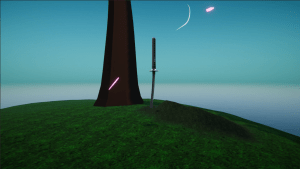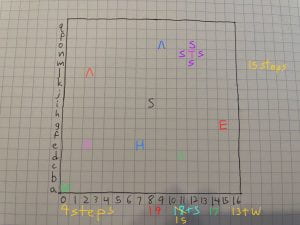Artist’s Statement:
I got the initial idea for this project by looking at what it meant to be an artgame. After reading John Sharp’s, “Works of Game” I was inspired by his description of an artgame game. I understood that artgames use the innate properties of games like interactivity, player goals, and game mechanics to create expressive play experiences that explore metaphysical questions around life, ethics, and aspects of the human condition. Unlike normal games, the systems in artgames tend to model ideas and concepts rather than phenomena from the physical and social world. This concept spoke to me because I have long been critical of the way the current gaming landscape tries to force an experience onto its players. Many modern games explain every single thing from every control to every facet of their narrative. I wanted to get away from that by creating an artgame that centered its interactivity, player goals, and game mechanics to give the player an experience that I found lacking in the modern gaming landscape. I believe that the modern gaming landscape lacks many games that try to get the player to experience a narrative without the use of any words. Even in the case where games do create a narrative without words they often rely on out-of-game descriptions, cutscenes, or endings to show the player that there is a deep narrative present. I wanted to get away from all of that and present the player with an experience and environment that has no given explanation. It’s up to the player to discover everything, end when they want, and interpret the game in their way.
This project relates to a few of the artgames discussed in the readings. One of the games that relates is “The Marriage” by Rod Humble. “The Marriage” does not explain its mechanics, message, or narrative to the player and instead leaves it up to the player to discover and interpret for themselves. The mechanics themselves are simple yet the combination of the mechanics and how the squares react are what make the game so interesting to play. The readings also stated that it was unlikely that people would come out of the game with the message that the creator intended. This game is similar to what I wanted to do with my game because I want the player to experience the game without being told what to do. If they come out of the experience with a different meaning than what I intended that is perfectly fine and even encouraged by me because it will make conversations about my game more interesting. My game also attempts to use its subtle mechanics to help paint a narrative. The game also relates to “Papers, Please” because it has a very stylized art style and ends when you want it to end.
A lot of the other influence and intention is explained in the “Documentation / Process” section below.
Documentation / Process:
This section will spoil a lot of the intent behind the game so I would only read this part if you do not want to experience the game in the way it was intended to be experienced. After I decided on how I wanted to convey my narrative, I then wanted to figure out what I wanted my narrative to be. I decided that I wanted to have my narrative be about a fallen samurai because I had Japanese history and the game “Okami” on my mind at the time. I didn’t want to tell a sad story though, instead, I wanted my narrative to be whimsical and use VFX and audio as well as a well-crafted level to tell its story. This along with inspiration from the Xenoblade Chronicles series gave me a start on what I wanted the level to look like. Xenoblade Chronicles 1 and 2 both feature ethereal, majestic trees that I wanted to try to replicate. I thought that a magical-looking sakura tree would be the perfect place to bury a samurai. Furthermore, a well-respected and battle-tested samurai would likely want to be buried in a peaceful spot where they could be one with nature. This helped me settle on the island surrounded by water and helped me pick the sounds that I wanted to incorporate. I added wave noises that increase in volume as you approach the water as well as the song “Satorl Marsh (Night)” from the Xenoblade Chronicles Definitive Edition soundtrack. I felt that this song would be the perfect choice for the game as it strikes an immaculate balance between Zen and whimsy. The song is one of my favorites and often makes me more in tune with my emotions like I hoped it would for the player. This song choice also helped inform my next decision which was to add a day and night cycle. I wanted to make it feel like even though you were dead the world kept moving, time kept moving. The area of Satorl Marsh (where the song is from) is also extremely interesting as it is unassuming during the day, but at night the trees start to glow, ether starts to float into the atmosphere, and the music gets intense. Using this inspiration I created the ether particles that move into the air to capture the sense of whimsy and beauty that area had. These visual effects also make the island feel spiritual in a way like the tree and particles make the island seem like a place where spirits would want to rest. This idea informed a lot of the decisions related to my mechanics. The spiritual feel of the island made me want to make the player character the spirit of the dead samurai who was chained to this island after their death. To accomplish this I started by creating a movement system with low-gravity physics. This was in an attempt to make you feel floaty like a ghost or spirit. I also added a very high jump/float if you press/hold the space bar to increase this feeling. Additionally, I removed the player’s shadow and made them be able to walk through the sword and tree showing that they do not have a physical form. Despite all of this, I still felt like it would be hard to tell who you were. To fix this, I made it so that particles of a humanoid figure follow where you were at night. This makes it so that the player is rewarded for looking around and that you can see that something ghostly is going on. Lastly, to accomplish the feeling of being chained to the island, I wanted to make it so that the farther away you got from the katana the slower you would move. Nothing is stopping you from moving far away, but it is clear that the island wants you to rest in peace.
Through playtesting, I learned that the tree trunk and the grass were distracting from the overall Zen and carefully crafted feel of the level, so I tried my best to improve them. I also learned that players had extremely different interpretations of what was happening, ranging from “the island is pretty” to “I liked that I was a ghost samurai.” I think the thing that I heard that made me feel like this was successful was when a playtester told me that they enjoyed that they had to think through the game and they liked that nothing was told to them.
Links:
- Game: https://drive.google.com/file/d/12Bx_Z0xHtnAee49fLxPxJAqhLteOa47t/view?usp=sharing
- Asset Links:







